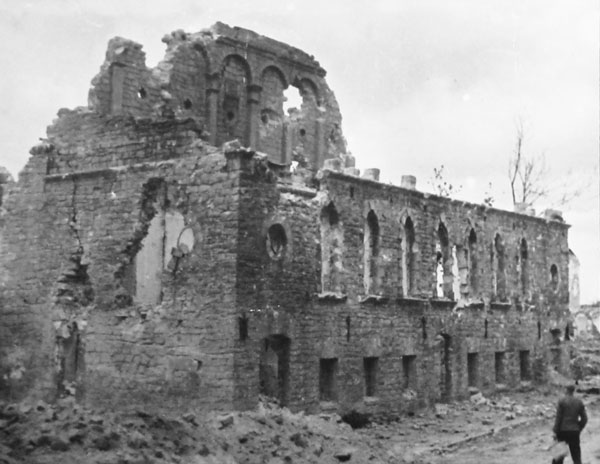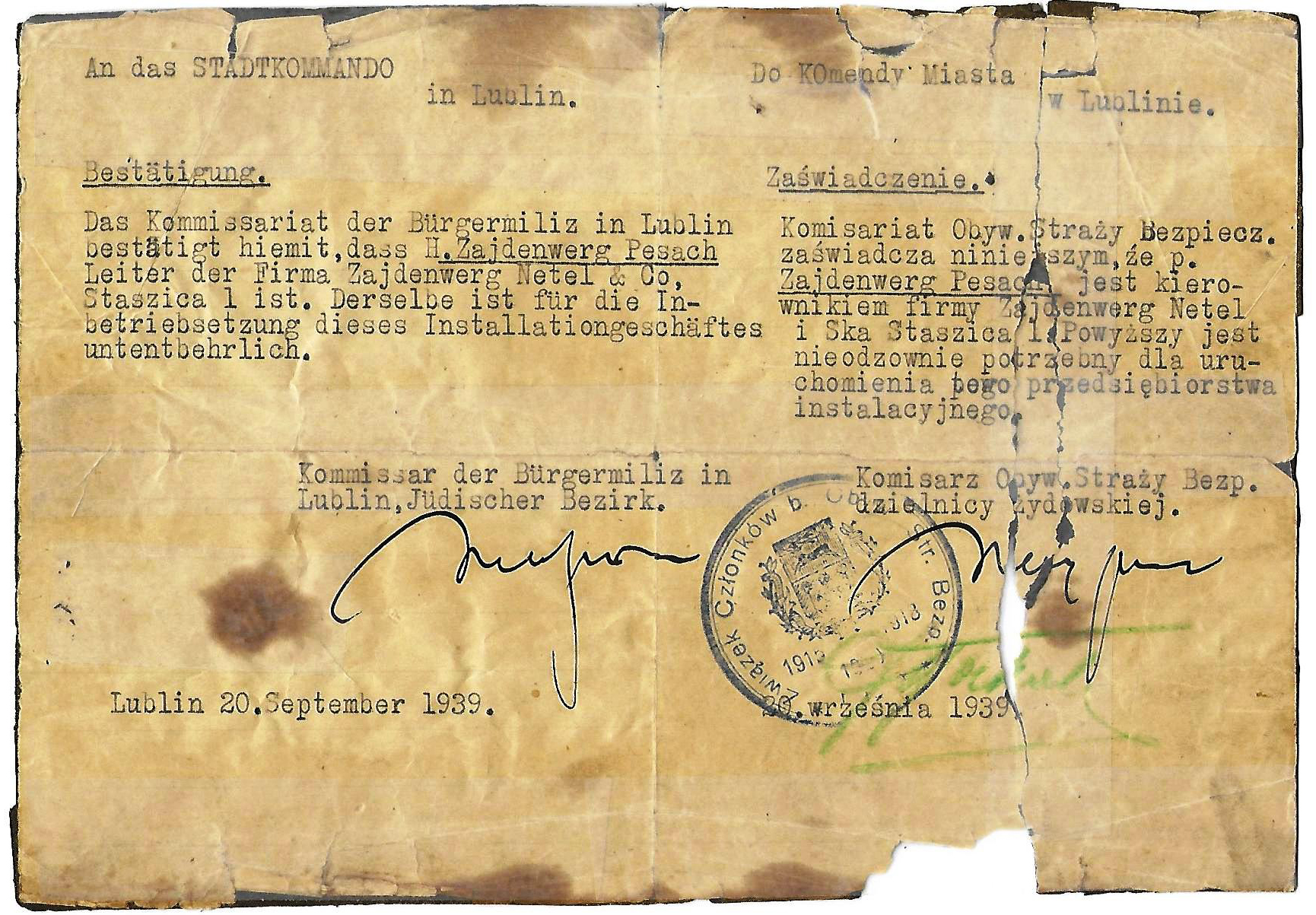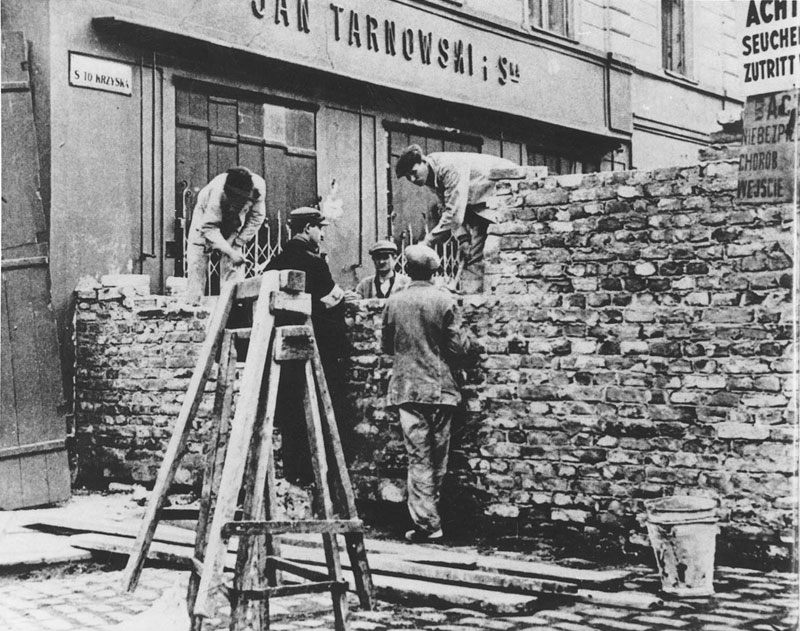|
The Black Book Of Polish Jewry
''The Black Book of Polish Jewry'' is a 400-page report about the progress of the Holocaust in Poland published in 1943 during World War II by the American Federation for Polish Jews in cooperation with the Association of Jewish Refugees and Immigrants from Poland. It was compiled by Jacob Apenszlak with Jacob Kenner, Isaac Lewin and Moses Polakiewicz, and released by Roy Publishers of New York with an introduction by Ignacy Schwarzbart from the National Council of the Polish Republic. The book was sponsored by Eleanor Roosevelt, Albert Einstein, US Senator Robert Wagner, and other high-ranking community leaders. Historian Michael Fleming suggests it downplayed the true scale and manner of the Holocaust in an effort to elicit the empathy of its readership. Contents ''The Black Book of Polish Jewry'' is a compendium of information collected and summarized from the plethora of already available sources including ''The Polish Fortnightly Review'' series published by the Polish Mi ... [...More Info...] [...Related Items...] OR: [Wikipedia] [Google] [Baidu] |
The Holocaust In Poland
The Holocaust in Poland was part of the European-wide Holocaust organized by Nazi Germany and took place in German-occupied Poland. During the genocide, three million Polish Jews were murdered, half of all Jews murdered during the Holocaust. The Holocaust in Poland was marked by the construction of death camps by Nazi Germany, German use of gas vans, and mass shootings by German troops and their Ukrainian and Lithuanian auxiliaries. The extermination camps played a central role in the extermination both of Polish Jews, and of Jews whom Germany transported to their deaths from western and southern Europe. Every branch of the sophisticated German bureaucracy was involved in the killing process, from the interior and finance ministries to German firms and state-run railroads. Approximately 98 percent of Jewish population of Nazi-occupied Poland during the Holocaust were killed. About 350,000 Polish Jews survived the war; most survivors never lived in Nazi-occupied Poland, but ... [...More Info...] [...Related Items...] OR: [Wikipedia] [Google] [Baidu] |
Treblinka Extermination Camp
Treblinka () was an extermination camp, built and operated by Nazi Germany in occupied Poland during World War II. It was in a forest north-east of Warsaw, south of the village of Treblinka in what is now the Masovian Voivodeship. The camp operated between 23 July 1942 and 19 October 1943 as part of Operation Reinhard, the deadliest phase of the Final Solution. During this time, it is estimated that between 700,000 and 900,000 Jews were murdered in its gas chambers, along with 2,000 Romani people. More Jews were murdered at Treblinka than at any other Nazi extermination camp apart from Auschwitz-Birkenau. Managed by the German SS with assistance from Trawniki guards – recruited from among Soviet POWs to serve with the Germans – the camp consisted of two separate units. Treblinka I was a forced-labour camp (''Arbeitslager'') whose prisoners worked in the gravel pit or irrigation area and in the forest, where they cut wood to fuel the cremation pits. Between 1941 and 1 ... [...More Info...] [...Related Items...] OR: [Wikipedia] [Google] [Baidu] |
Tarnopol Ghetto
The Tarnopol Ghetto ( pl, getto w Tarnopolu, german: Ghetto Tarnopol) was a Jewish World War II ghetto established in 1941 by the ''Schutzstaffel'' (''SS'') in the prewar Polish city of Tarnopol (now Ternopil, Ukraine). Joshua D. Zimmerman (2015), The Polish Underground and the Jews, 1939–1945.' Cambridge University Press via Google Books. "The Provinces of Poland on the Eve of World War II," pp. xviii, 278, 328, 347. At Teheran (1943) Churchill told Stalin that he wished to see a new Poland "friendly to Russia". Stalin replied that nevertheless, he considered the annexation of Eastern Poland "just and right" only along the frontiers of the Nazi-Soviet invasion of 1939. . 351/sup> Background According to Polish census of 1931, Jews constituted 44% of the city's diverse multicultural makeup.Central Statistical Office (Poland), Drugi Powszechny Spis Ludności. Woj.tarnopolskie, 1931. PDF file, 21.09 MB. The complete text of the Polish census of 1931 for the Tarnopol Voivodeshi ... [...More Info...] [...Related Items...] OR: [Wikipedia] [Google] [Baidu] |
Stanisławów Ghetto
Stanisławów Ghetto ( pl, getto w Stanisławowie, german: Ghetto Stanislau) was a Nazi ghetto established in 1941 by the Schutzstaffel, SS in Stanislavov (now Ivano-Frankivsk) in Western Ukraine. Before 1939, the town was part of the Second Polish Republic. After the German invasion of the Soviet Union, Nazi Germany incorporated the town into District of Galicia, as the fifth district of the semi-colonial General Government. On 12 October 1941, during the so-called Bloody Sunday, some 10,000–12,000 Jews were shot into mass graves at the Jewish cemetery by the German uniformed SS-men from Sicherheitspolizei, SIPO and Order Police battalions together with the Ukrainian Auxiliary Police. Dr. Tenenbaum of the Judenrat refused the offer of exemption and was killed along with the others. Two months after that, the ghetto was established officially for the 20,000 Jews still remaining, and sealed off with walls on 20 December 1941. Over a year later, in February 1943, the Ghetto was ... [...More Info...] [...Related Items...] OR: [Wikipedia] [Google] [Baidu] |
Lwów Ghetto
, location = Lwów, Zamarstynów(German-occupied Poland) , date = 8 November 1941 to June 1943 , incident_type = Imprisonment, mass shootings, forced labor, starvation, forced abortions and sterilization , perpetrators = , participants = , organizations = SS , camp = Belzec extermination camp Janowska concentration camp , ghetto = , victims = 120,000 Polish Jews , survivors = 823 , witnesses = , documentation = , memorials = , notes = The Lwów Ghetto (german: Ghetto Lemberg; pl, getto we Lwowie) was a Nazi ghetto in the city of Lwów (now Lviv, Ukraine) in the territory of Nazi-administered General Government in German-occupied Poland. The ghetto, set up in the second half of 1941, was liquidated in June 1943; all its inhabitants who survived prior killings were deported to the Bełżec extermination camp and the Janowska concentration camp. Background Lviv (Polish: Lwów) was a multicultural city j ... [...More Info...] [...Related Items...] OR: [Wikipedia] [Google] [Baidu] |
Killing Squads Of Operation Barbarossa
Killing, Killings, or The Killing may refer to: Arts, entertainment, and media Films * ''Killing'' (film), a 2018 Japanese film * ''The Killing'' (film), a 1956 film noir directed by Stanley Kubrick Television * ''The Killing'' (Danish TV series), a police procedural drama first broadcast in 2007 * ''The Killing'' (U.S. TV series), a crime drama based on the Danish television series, first broadcast in 2011 Literature * ''Killing'' (comics), Italian photo comic series about a vicious vigilante-criminal * ''Killing'', a series of historical nonfiction books by Bill O'Reilly and Martin Dugard * "Killings" (short story), a short story by Andre Dubus * ''The Killing'' (Muchamore novel), a CHERUB series installment by Robert Muchamore * ''The Killing'', a 2012 novelization of the Danish TV series by David Hewson Music * "Killing", a song on the album '' Echoes'' by The Rapture * "Killing", a song from an untitled Korn album released in 2007 * ''The Killing'' (EP), by Hatesph ... [...More Info...] [...Related Items...] OR: [Wikipedia] [Google] [Baidu] |
Grodno Ghetto
The Grodno Ghetto ( pl, getto w Grodnie, be, Гродзенскае гета, he, גטו גרודנו) was a Nazi ghetto established in November 1941 by Nazi Germany in the city of Grodno for the purpose of persecution and exploitation of Jews in Western Belarus. The ghetto, run by the SS, consisted of two interconnected areas about 2 km apart. Ghetto One was established in the Old Town district, around the synagogue (''Shulhoif''), with some 15,000 Jews crammed into an area less than half a square kilometre. Ghetto Two was created in the Slobodka suburb, with around 10,000 Jews incarcerated in it. Ghetto Two was larger than the main ghetto but far more ruined. The reason for the split was determined by the concentration of Jews within the city and less need to transfer them from place to place. Their situation had considerably worsened with the ghettos' locations highly inadequate in terms of sanitation, water and electricity. The separation of the ghettos would later ... [...More Info...] [...Related Items...] OR: [Wikipedia] [Google] [Baidu] |
Brześć Ghetto
The Brześć Ghetto or the Ghetto in Brest on the Bug, also: Brześć nad Bugiem Ghetto, and Brest-Litovsk Ghetto ( pl, getto w Brześciu nad Bugiem, yi, בריסק or בריסק-ד׳ליטע) was a Nazi ghetto created in occupied Western Belarus in December 1941, six months after the German troops had invaded the Soviet Union in June 1941. Less than a year after the creation of the ghetto, around 1942, most of approximately 20,000 Jewish inhabitants of Brest (Brześć) were murdered; over 5,000 were executed locally at the Brest Fortress on the orders of Karl Eberhard Schöngarth; the rest in the secluded forest of the Bronna Góra extermination site (the Bronna Mount, be, Бронная гара), sent there aboard Holocaust trains under the guise of 'resettlement'.The statistical data compiled on the basis o"Glossary of 2,077 Jewish towns in Poland" by ''Virtual Shtetl'' Museum of the History of the Polish Jews , as well a"Getta Żydowskie," by ''Gedeon'' and " ... [...More Info...] [...Related Items...] OR: [Wikipedia] [Google] [Baidu] |
Warsaw Ghetto
The Warsaw Ghetto (german: Warschauer Ghetto, officially , "Jewish Residential District in Warsaw"; pl, getto warszawskie) was the largest of the Nazi ghettos during World War II and the Holocaust. It was established in November 1940 by the German authorities within the new General Government territory of occupied Poland. At its height, as many as 460,000 Jews were imprisoned there, in an area of , with an average of 9.2 persons per room, barely subsisting on meager food rations. From the Warsaw Ghetto, Jews were deported to Nazi concentration camps and mass-killing centers. In the summer of 1942, at least 254,000 ghetto residents were sent to the Treblinka extermination camp during under the guise of "resettlement in the East" over the course of the summer. The ghetto was demolished by the Germans in May 1943 after the Warsaw Ghetto Uprising had temporarily halted the deportations. The total death toll among the prisoners of the ghetto is estimated to be at least 300,000 kill ... [...More Info...] [...Related Items...] OR: [Wikipedia] [Google] [Baidu] |
Holocaust Trains
Holocaust trains were railway transports run by the ''Deutsche Reichsbahn'' national railway system under the control of Nazi Germany and its allies, for the purpose of forcible deportation of the Jews, as well as other victims of the Holocaust, to the Nazi concentration, forced labour, and extermination camps. The speed at which people targeted in the "Final Solution" could be exterminated was dependent on two factors: the capacity of the death camps to gas the victims and quickly dispose of their bodies, as well as the capacity of the railways to transport the victims from Nazi ghettos to extermination camps. The most modern accurate numbers on the scale of the "Final Solution" still rely partly on shipping records of the German railways. Pre-war The first mass deportation of Jews from Nazi Germany, the ''Polenaktion'', occurred in October 1938. It was the forcible eviction of German Jews with Polish citizenship fuelled by the ''Kristallnacht''. Approximately 30,000 Jews w ... [...More Info...] [...Related Items...] OR: [Wikipedia] [Google] [Baidu] |
Lublin Ghetto
, location = Lublin, German-occupied Poland , date = , incident_type = Imprisonment, forced labor, starvation, exile , perpetrators = , participants = , organizations = SS , camp = deportations to Belzec extermination camp and Majdanek , ghetto = , victims = 34,000 Polish Jews , survivors = , witnesses = , documentation = , memorials = The Lublin Ghetto was a World War II ghetto created by Nazi Germany in the city of Lublin on the territory of General Government in occupied Poland. The ghetto inmates were mostly Polish Jews, although a number of Roma were also brought in.Doris L. Bergen ''War & Genocide: A Concise History of the Holocaust'' Rowman & Littlefield, 2002, pg. 144. . Set up in March 1941, the Lublin Ghetto was one of the first Nazi-era ghettos slated for liquidation during the most deadly phase of the Holocaust in occupied Poland.Lawrence N. Powell, ''Troubled Memory: Anne Levy, the Holocaust, ... [...More Info...] [...Related Items...] OR: [Wikipedia] [Google] [Baidu] |
Nazi Ghetto
Beginning with the invasion of Poland during World War II, the Nazi Germany, Nazi regime set up ghettos across German-occupied Europe, German-occupied Eastern Europe in order to segregate and confine Jews, and sometimes Romani people, into small sections of towns and cities furthering their exploitation. In German documents, and signage at ghetto entrances, the Nazis usually referred to them as ''Jüdischer Wohnbezirk'' or ''Wohngebiet der Juden'', both of which translate as the Jewish Quarter (diaspora), Jewish Quarter. There were several distinct types including ''open ghettos'', ''closed ghettos'', ''work'', ''transit'', and ''destruction ghettos'', as defined by the Holocaust historians. In a number of cases, they were the place of Jewish underground resistance against the German occupation, known collectively as the ghetto uprisings. Background and establishment of the ghettos The first anti-Jewish measures were enacted in Germany with the onset of Nazism; these measures d ... [...More Info...] [...Related Items...] OR: [Wikipedia] [Google] [Baidu] |








